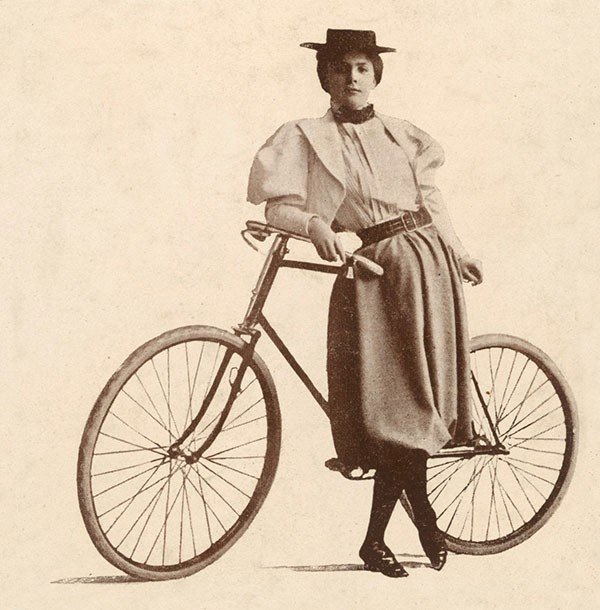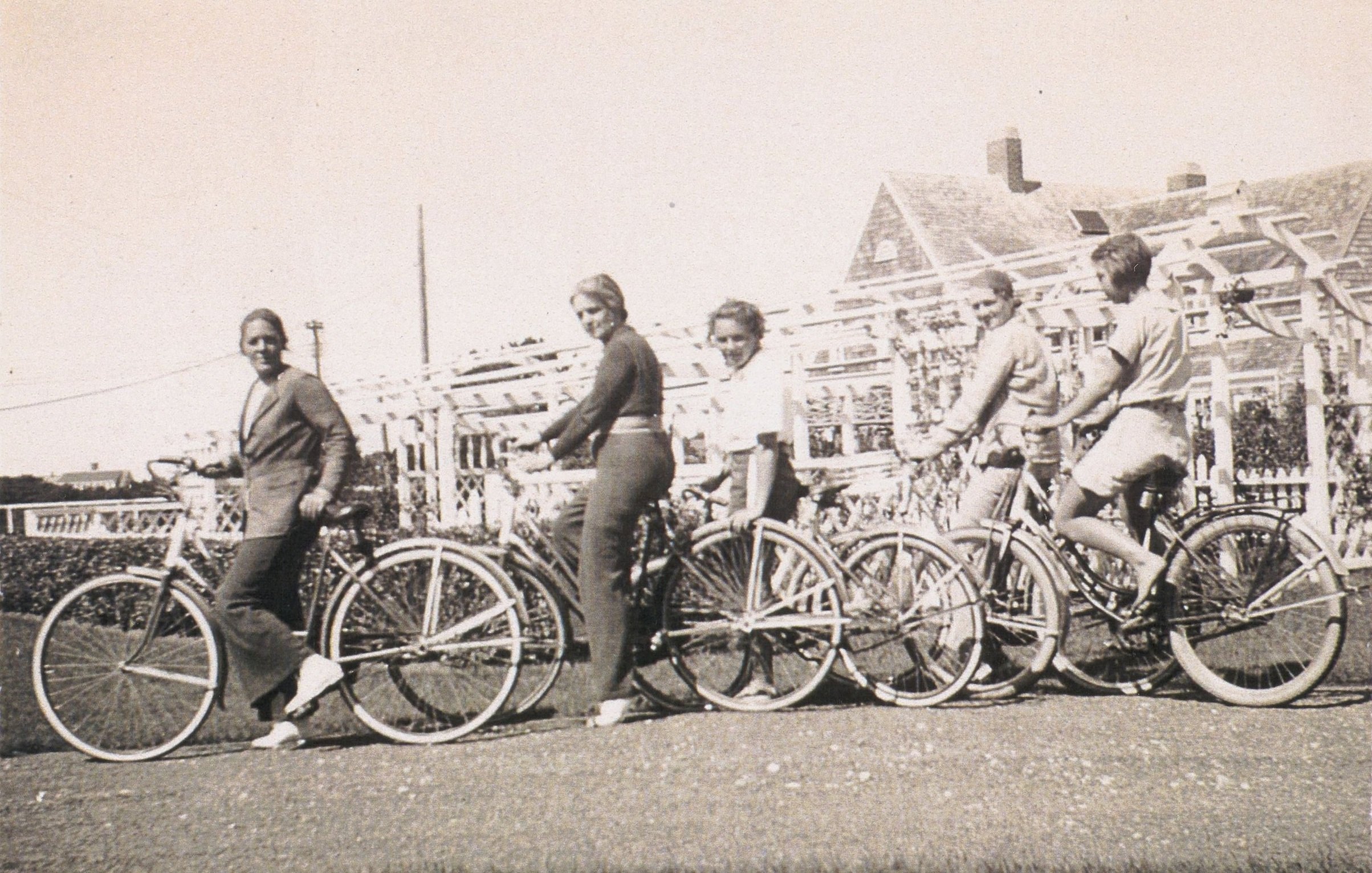The bicycle, known as “the wheel” in the 1800’s, was a vehicle used to bring freedom and change to women. In those days women were confined not only by rules of behavior but also by constricting clothing that made freedom of movement impossible. In the early 1800’s a woman’s place was in the home and her focus was on husband and family. However, the women’s rights movement was gathering steam and women were looking for more than just home and hearth. When we think of the women’s rights movement the bicycle does not come to mind! How could bicycles have played such a pivotal role and changed women’s lives? It makes sense when we realize the wheel gave women the ability to control their own transportation and brought about autonomy never before experienced. The bicycle literally shattered norms of what was thought to be proper conduct and dress for women. It brought about a new era in which women asserted control over their bodies and behavior.
At first, bicycles were difficult to ride. Early designs facilitated high speed by having a large front wheel and a tiny rear wheel. Pedals were located on the front wheel, which could be as much as five feet in diameter. One revolution of this large wheel with each full turn of the pedals would carry one forward by over 15 feet! This bicycle was called an Ordinary. However, no ordinary person could ride the thing. It took unusual strength and balance to mount and ride it. As one might expect, there were many accidents! A rut or small stone in the road could send a person flying over the handlebar. Learning how to “take a header” was the first thing needed in learning to ride an Ordinary.
In the 1870’s the Safety bicycle was introduced. These bicycles had equal sized front and rear wheels with a chain drive allowing centrally located pedals to power the rear wheel. The Safety was indeed a superior design making it faster, more stable and easier to mount than the Ordinary. The Safety is still the basic bicycle design used today. Because this new bicycle was so much easier to manage, it became all the rage of the 1890’s.
As cycling became more popular, a “new woman” evolved. This term was used for women who broke with tradition by working outside the home, becoming politically active in the women’s suffrage movement, or who saw herself equal to men. For this kind of woman, the bicycle was perfect! As these women took to their wheel, they discovered freedom of movement and a sense that they could now be equal to men.
Newspapers of the day printed much about the public display of a woman riding her wheel. Some quotes of the times included; “The bicycle took ‘old fashioned, slow going notions of the gentler sex and replaced them with some new woman, mounted on her steed of steel.’ ” (The Courier, Nebraska, 1895). Another article written by a reporter for the San Francisco Call in 1895 stated; “It really doesn’t matter much where this one individual young lady is going on her wheel. It may be that she’s going to the park on pleasure bent, or to the store for a dozen hairpins, or to call on a sick friend at the other side of town, or to get a daily pattern of somebody, or a recipe for removing tan and freckles. Let that be as it may. What the interested public wishes to know is, Where are all the women on wheels going? Is there a grand rendezvous somewhere toward which they are all headed and where they will sometime hold a meet that will cause this wobbly old world to wake up and readjust itself?” In 1891 the Sunday Herald, in an article entitled The Woman On A Bicycle printed; “I think the most vicious thing I ever saw in all my life is a woman on a bicycle – and Washington is full of them. I had thought that cigarette smoking was the worst thing a woman could do, but I have changed my mind.”
The bicycle ushered in a whole new fashion of exposed ankles and visible bloomers! Bloomers, baggy trousers, sometimes called a divided skirt, were cinched at the knee. The cycling craze mandated changes in clothing. These clothing changes caused high emotions, challenging perceptions regarding femininity and were fraught with intensity. Even the medical profession had a say regarding bloomers. At the Mississippi Valley Medical Congress in 1895, cycling was said to be a healthy exercise for both men and women, however the bloomers were termed “something outrageous” and they were “unanimously declared to be an abomination and the cause of lowering their wearers in the eyes of spectators.” There was no medical reason given for this statement. Eventually it was accepted that women could ride the wheel wearing comfortable clothing. Bicycles were indeed bringing about women’s freedom. Susan B. Anthony wrote; “I think it has done more to emancipate women than anything else in the world. It gives women a feeling of freedom and self–reliance.”
There is one thing you may never have thought of regarding riding a bicycle. It is the problem of Bicycle Face. In 1895, The Literary Digest described the condition as; “ . . . usually flushed, but sometimes pale, often with lips more or less drawn, and the beginning of dark shadows under the eyes, and always with an expression of weariness.” Women were most affected by this condition. Women responded to such statements with strong emotions. In the 1890’s, a report in the Chicago Daily News stated; “When a woman wants to learn anything or do anything useful or even have any fun there is always someone to solemnly warn her that it is her duty to keep well. Meanwhile, in many states she can work in factories ten hours a day, she can stand behind counters in badly ventilated stores from 8 o’clock to 6, she can bend over the sewing machine for about 5 cents an hour and no one cares enough to protest. But when these same women, condemned to sedentary lives indoors, find a cheap and delightful way of getting the
fresh air and exercise they need so sorely, there is a hue and cry about their physical welfare.” The fear of women riding into their new world of freedom gave way to scare tactics and rules such as “don’t refuse assistance up a hill.” Eventually, Bicycle Face went by the way of misdiagnosis.
A woman on a bicycle no longer needed a man for transportation. She could come and go as she pleased. At twenty-three, Annie Kopclovsky was an unusual woman for her time in 1894. When two men made a bet that no woman could encircle the globe on her wheel, Annie took up the challenge. She left Boston in full skirts on a 42 pound Columbia bicycle. She cycled through Europe and North Africa and went on to the South Pacific before returning to the United States via San Francisco. Fifteen months after beginning her trek, she rode into Boston clad in Bloomers. She became an advocate for both cycling and women’s rights.
The wheel was women’s way to freedom. In 1895, Frances Willard, a suffragist and founder of the Women’s Christian Temperance Union, resolved to ride a bicycle at age 53. She did so because she, “wanted to help women to a wider world – from natural love of adventure – a love long hampered and impeded – and from a love of acquiring this new implement of power and literally putting it underfoot.” She and so many other women took to the wheel and rode into a new life of freedom. Women were on a new path!
by Ruth Weissberger
Women riding their bikes in West Yarmouth, near the Englewood Hotel.
Photo at top: Caroline (Thacher) Harris, about 1895.




